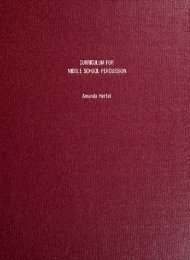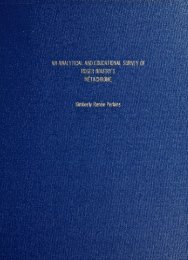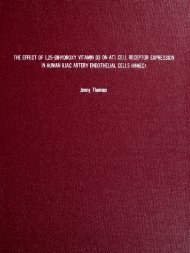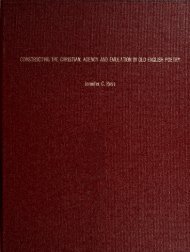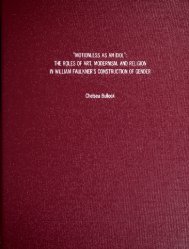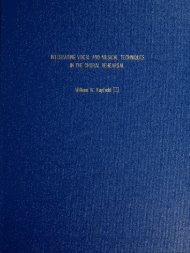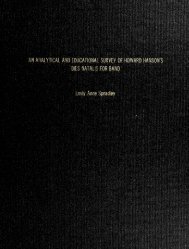The Effect of Aposematic Coloration on the Food Preference of ...
The Effect of Aposematic Coloration on the Food Preference of ...
The Effect of Aposematic Coloration on the Food Preference of ...
- No tags were found...
You also want an ePaper? Increase the reach of your titles
YUMPU automatically turns print PDFs into web optimized ePapers that Google loves.
aposematic prey are not clearly understood. However, according to Speed (2000), it is likelythat <strong>the</strong> learning abilities and memory <str<strong>on</strong>g>of</str<strong>on</strong>g> predators may have c<strong>on</strong>tributed to <strong>the</strong> success andevoluti<strong>on</strong> <str<strong>on</strong>g>of</str<strong>on</strong>g> <strong>the</strong> bold appearance <str<strong>on</strong>g>of</str<strong>on</strong>g> noxious prey.Without <strong>the</strong> ability <str<strong>on</strong>g>of</str<strong>on</strong>g> predators to recallexperiences, warning colorati<strong>on</strong> would serve no adaptive purpose because each encounter wouldtrigger an independent resp<strong>on</strong>se - a resp<strong>on</strong>se based <strong>on</strong> no previous knowledge.Ano<strong>the</strong>r factorthat may have c<strong>on</strong>tributed to <strong>the</strong> adaptive value <str<strong>on</strong>g>of</str<strong>on</strong>g> aposematic colorati<strong>on</strong> is <strong>the</strong> aggregati<strong>on</strong> <str<strong>on</strong>g>of</str<strong>on</strong>g>aposematic prey. It is expected that a predator would have readily attacked a solitaryc<strong>on</strong>spicuous individual due to its visibility (Alatalo and Mappes 1996).Distaste for <strong>the</strong> unusualindividual would not have c<strong>on</strong>tributed to avoidance learning because <strong>the</strong>re were no o<strong>the</strong>rexamples <str<strong>on</strong>g>of</str<strong>on</strong>g> <strong>the</strong> c<strong>on</strong>spicuous prey to immediately avoid.This absence <str<strong>on</strong>g>of</str<strong>on</strong>g> repetitive encounterswould have mitigated <strong>the</strong> effects <str<strong>on</strong>g>of</str<strong>on</strong>g> avoidance learning, providing no evoluti<strong>on</strong>ary benefit to <strong>the</strong>prey species.Aggregati<strong>on</strong> <str<strong>on</strong>g>of</str<strong>on</strong>g> aposematic prey, <strong>on</strong> <strong>the</strong> o<strong>the</strong>r hand, would have resulted inpredator attack <strong>on</strong> <strong>the</strong> prey, rejecti<strong>on</strong> based <strong>on</strong> <strong>the</strong> unpalatable nature <str<strong>on</strong>g>of</str<strong>on</strong>g> <strong>the</strong> prey, and associati<strong>on</strong><str<strong>on</strong>g>of</str<strong>on</strong>g> that individual with <strong>the</strong> surrounding group.Thus, <strong>the</strong> result would have been aband<strong>on</strong>ment <str<strong>on</strong>g>of</str<strong>on</strong>g><strong>the</strong> group for different prey, leaving <strong>the</strong> brightly colored survivors to pass <strong>on</strong> <strong>the</strong>ir genes andincrease <strong>the</strong> frequency <str<strong>on</strong>g>of</str<strong>on</strong>g> warning colorati<strong>on</strong> within <strong>the</strong>ir species (Alatalo and Mappes 1996).As emphasized by Shettleworth (2001) in a review <str<strong>on</strong>g>of</str<strong>on</strong>g> animal cogniti<strong>on</strong> and behavior, bothaggregati<strong>on</strong> <str<strong>on</strong>g>of</str<strong>on</strong>g> aposematic prey and learning resp<strong>on</strong>se <str<strong>on</strong>g>of</str<strong>on</strong>g> predators seem to have played relatedroles in <strong>the</strong> advancement <str<strong>on</strong>g>of</str<strong>on</strong>g> aposematic colorati<strong>on</strong>.III.Examples <str<strong>on</strong>g>of</str<strong>on</strong>g> <str<strong>on</strong>g>Aposematic</str<strong>on</strong>g> <str<strong>on</strong>g>Colorati<strong>on</strong></str<strong>on</strong>g>Observati<strong>on</strong>s in nature have played a significant role in understanding and identifying <strong>the</strong>aposematic predator-prey interacti<strong>on</strong>s that exist.A specific example <str<strong>on</strong>g>of</str<strong>on</strong>g> functi<strong>on</strong>ing aposematiccolorati<strong>on</strong> in nature is seen in <strong>the</strong> South American arrow-pois<strong>on</strong> frog.This frog has a bright red



